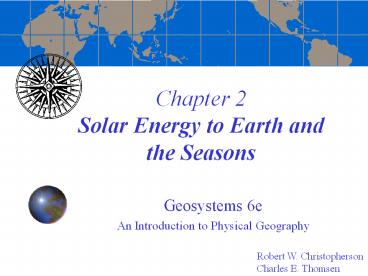Chapter 2 Solar Energy to Earth and the Seasons - PowerPoint PPT Presentation
Title:
Chapter 2 Solar Energy to Earth and the Seasons
Description:
Seasonality: the variation of the sun's position over the horizon; the changing ... Axis maintains alignment during orbit around the Sun ... – PowerPoint PPT presentation
Number of Views:445
Avg rating:3.0/5.0
Title: Chapter 2 Solar Energy to Earth and the Seasons
1
Chapter 2Solar Energy to Earth and the Seasons
- Geosystems 6e
- An Introduction to Physical Geography
Robert W. Christopherson Charles E. Thomsen
2
The Solar System, Sun, and Earth
- Solar system formation and structure
- Gravity
- Mutual attracting force exerted by the mass of an
object on all other objects - Planetesimal hypothesis
- Explains the formation of planets and other
celestial bodies - A nebular cloud of dust, gas, and icy comets
condensed to form universe
3
Dimensions and Distances
- Speed of light
- Light travels 6 trillion miles per year
- The distance light travels in a year is called a
light year (ly) - Milky Way Galaxy 100,000 ly across
- Our Solar System 11 light-hours across
- Moon is 1.28 light-seconds away
4
Milky Way Galaxy
Figure 2.1
5
Our New Solar System
6
Solar Energy From Sun to Earth
- The Sun
- Intercepted energy at the top of the atmosphere
- The suns principle outputs
- Radiant energy and solar wind
7
Solar Activity and Solar Wind
- Solar wind clouds of electrically charged
particles - Sunspots are caused by magnetic storms. These
cause changes in the solar output. - Sunspots have activity cycle of 11 years
Figure 2.2
8
Transmission of Energy
- Conduction molecule to molecule transfer of
energy as it diffuses through a substance. - Hot pan hand
- Convection transfer of energy by physical mixing
involving strong vertical motion. - Steam rising from boiling water
9
Transmission of Energy
- Advection transfer of energy by physical mixing
involving strong horizontal motion. - Air rushing in through an opened door
- Radiation emission and propagation of energy in
the form of EM waves - sunlight
10
The Electromagnetic Spectrum
- EM Spectrum all the radiant energy produced by
the sun placed in an ordered range, divided by
wavelength - Weins Law hotter objects emit shorter
wavelengths - Shorter wavelengths have higher energy
- Sun radiates shortwave energy
- Earth radiates longwave energy
11
Earths Energy Budget
Figure 2.8
12
Distribution of Insolation
- Insolation Radiation arriving at the Earths
atmosphere and surface - Solar constant the amount of solar radiation
received in the atmosphere - Subsolar point the point on Earth where the
suns rays are perpendicular to the surface
maximum insolation received
13
Distribution of Insolation
- Tropics receive more concentrated insolation due
to the Earths curvature - Tropics receive 2.5X more than poles
- Solar rays pass through more atmosphere before
reaching the poles, so more energy is lost to
scattering, absorption, and reflection
14
Figure 2.9
15
- Solar declination latitudinal change of
subsolar points
16
The Seasons
- Seasonality the variation of the suns position
over the horizon the changing daylength during
the year - Seasons result from
- variations in the suns altitude angle between
the horizon and the sun - the sunss declination latitude of the subsolar
point - and daylength - duration of exposure to
insolation
17
Reasons for Seasons
- Variations in the suns altitude, declination,
and daylength are caused by - Revolution
- Rotation
- Tilt of Earths axis
- Axial parallelism
- Sphericity
18
Reasons for Seasons
- Revolution
- Earth revolves around the Sun
- One complete revolution is 365.25 days
- Orbit is elliptical, not circular
- Rotation
- Earth rotates on its axis once every 24 hours
- Earth rotates counter-clockwise
19
Revolution and Rotation
Figure 2.13
20
Reasons for Seasons
- Tilt of Earths axis
- Axis is tilted 23.5 from plane of ecliptic
- Axial parallelism
- Axis maintains alignment during orbit around the
Sun - North pole points toward the North Star (Polaris)
- Sphericity
21
Axial Tilt and Parallelism
Figure 2.14
22
Annual March of the Seasons
- Winter solstice December 21 or 22
- Subsolar point Tropic of Capricorn
- Spring equinox March 20 or 21
- Subsolar point Equator
- Summer solstice June 20 or 21
- Subsolar point Tropic of Cancer
- Fall equinox September 22 or 23
- Subsolar point Equator
23
Annual March of the Seasons
Figure 2.15
24
End of Chapter 2
- Geosystems 6e
- An Introduction to Physical Geography
Robert W. Christopherson Charles E. Thomsen































